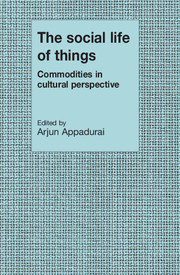Book contents
- Frontmatter
- Contents
- Contributors
- Foreword
- Preface
- Part I Toward an anthropology of thing
- Part II Exchange, consumption, and display
- Part III Prestige, commemoration, and value
- 5 Varna and the emergence of wealth in prehistoric Europe
- 6 Sacred commodities: the circulation of medieval relics
- Part IV Production regimes and the sociology of demand
- Part V Historical transformations and commodity codes
- Index
5 - Varna and the emergence of wealth in prehistoric Europe
Published online by Cambridge University Press: 05 June 2014
- Frontmatter
- Contents
- Contributors
- Foreword
- Preface
- Part I Toward an anthropology of thing
- Part II Exchange, consumption, and display
- Part III Prestige, commemoration, and value
- 5 Varna and the emergence of wealth in prehistoric Europe
- 6 Sacred commodities: the circulation of medieval relics
- Part IV Production regimes and the sociology of demand
- Part V Historical transformations and commodity codes
- Index
Summary
A contrast is often drawn between societies with relatively undifferentiated and unspecialized economic systems on the one hand, and those where craft-specialist production and large-scale exchange of commodities take a significant role on the other. In the former, sometimes described as operating under a “domestic mode of production,” activities yielding food for local consumption occupy most participants for most of their working time, and the exchange of goods takes place mainly in order to obtain necessary or desirable items from neighboring territories. In the latter, commercial activities play a significant role, and production and exchange for gain occupy a substantial proportion of the population.
This distinction was emphasized by the “substantivists” among economic anthropologists, notably Polanyi (1957), who stressed the “embeddedness” of the economy within a wider social matrix in most early societies. They criticized the tendency of the “formalists” among their colleagues to apply the analytic techniques of the modern economist, developed primarily for the description of modern industrial economies, to the very much simpler societies under consideration. The substantivists argued that the economic man of the modern economist could not be assumed to have operated in the societies in question. Clearly there is much justice in that critique, but Adams (1974) has pointed out that the market mentality, the desire to make a profit, is certainly not restricted to the modern world or to that of classical antiquity. To claim that the market was an innovation of ancient Greece, as Polanyi effectively did, may have been to oversimplify.
- Type
- Chapter
- Information
- The Social Life of ThingsCommodities in Cultural Perspective, pp. 141 - 168Publisher: Cambridge University PressPrint publication year: 1986
- 52
- Cited by



